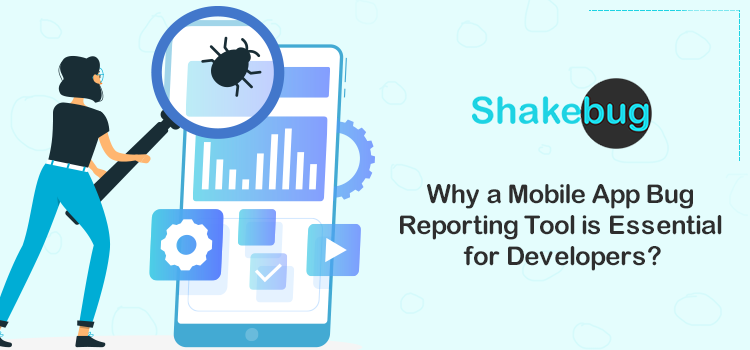As mobile app developers, we understand the importance of providing our users with high-quality products. No matter how much time and effort we spend on our apps, there’s always the potential for bugs and errors to appear after they’re released.
To ensure that our apps are running as smoothly and efficiently as possible, we must use a reliable mobile app bug-reporting tool and no one can underestimate the benefits of bug reporting tool. In this blog post, we will discuss why bug reporting is important, and how it can help us provide our users with the best possible product.
The Importance of Mobile App Bug Reporting
Mobile apps are ubiquitous in today’s society, and they are a vital part of the digital landscape. As such, mobile app developers must ensure the highest quality possible for their apps with the help of tools for mobile app development.
The only way to do this is through bug reporting, a tool that allows developers to identify and report different types of bugs with in app before it is released. Bug reporting helps to save developers time and money by alerting them of any problems before they reach the customer.
Additionally, bug reporting can greatly improve the overall quality of an app by allowing developers to address bugs quickly and easily. Without a bug reporting tool, a developer may miss important bugs that could lead to a decrease in quality and even customer dissatisfaction.
The Benefits of Using a Mobile App Bug Reporting Tool
A mobile app bug reporting tool is an essential resource for any developer, allowing them to easily identify and address potential issues before they become costly problems.
These tools provide developers with a wealth of information regarding how their applications are behaving in the real world, giving them the ability to detect and fix bugs as they arise quickly.
By having a bug reporting tool in place, developers can save time and money by fixing issues quickly and efficiently. Additionally, they can ensure the quality of their product by detecting and resolving issues that may have gone unnoticed otherwise.
This is especially important when developing apps for mobile devices since these devices can be unpredictable and often require specialized solutions to accommodate their unique hardware and software capabilities.
Using a mobile app bug reporting tool also allows developers to monitor their app’s performance over time and across multiple platforms. This helps to identify any problems that could lead to crashes or other issues that could affect the user experience.
With this data, developers can make informed decisions about where to focus their efforts and make sure that their application remains stable and reliable.
Overall, the benefits of having a bug-reporting tool in place are clear. By providing developers with valuable insights into the behaviour of their app, they can more effectively detect and fix bugs, improve the quality of their product, and save time and money in the long run.
Why Manual Bug Reporting is Challenging for Developers
Manual bug reporting can be a daunting task for developers. It requires manual testing of each application feature, which can be time-consuming and difficult to manage.
Additionally, the test environment must be closely monitored to ensure all variables are being tracked. This means that developers must be able to replicate all possible scenarios to accurately identify and document any bugs they come across. If any variables change during the testing process, it can result in unreliable or inaccurate results.
Furthermore, manual bug reporting is often slow and inefficient. Developers are forced to spend hours manually checking each feature and inputting the results into the system, which is prone to human error. This can lead to bugs slipping through the cracks, leaving users with a subpar experience. The process is also incredibly tedious and can quickly become overwhelming for developers.
Overall, manual bug reporting can be a lengthy and complicated process for developers. It is time-consuming, labour-intensive, and prone to human error. To combat these challenges, developers must find ways to automate the process and make bug reporting more efficient.
The Limitations of Traditional Bug Reporting Methods
Traditional bug-reporting methods have been around for decades and have served developers well, but they do come with their own set of limitations. These include manual processes such as filling out bug reports, collecting evidence manually and troubleshooting the issue in a long-winded process. The lack of automated testing and feedback can lead to delayed bug fixes, which can damage the user experience of a mobile app.
Additionally, traditional bug reporting methods don’t offer the same level of analytics and insights as a bug reporting tool does, meaning that developers are unable to quickly identify the root cause of any issues or prioritize which bugs should be fixed first.
Finally, manual bug reporting is often labour-intensive, requiring extra effort from developers to carry out.
Why a Mobile App Bug Reporting Tool is Essential
As the number of mobile apps being developed continues to increase, developers are increasingly relying on bug-reporting tools to ensure the quality and reliability of their applications.
A mobile app bug reporting software can help developers find and fix bugs in their applications more quickly, improving their overall user experience. This type of tool is essential for any app developer because it allows them to quickly identify and address any issues that could potentially lead to serious problems in the future.
Bug reporting tools also provide developers with a wealth of data about the health of their applications, which can be used to optimize performance and reduce risk.
By using a bug reporting tool, developers can ensure their applications are functioning properly, allowing them to stay ahead of potential problems and make sure their customers receive the best possible experience.
How a Mobile App Bug Reporting Tool Helps Developers
A mobile app bug reporting tool is essential for any developer who is creating or maintaining an app. A bug reporting tool can provide valuable insights into the usability and stability of a mobile app, helping developers quickly identify potential issues and make necessary adjustments.
With a bug reporting tool, developers can quickly get notified of bugs and crashes in their apps. This helps them stay on top of any potential problems that might arise, and take corrective action before the issue gets out of hand.
Additionally, bug reports can include detailed data about the user experience, such as the device type and operating system, providing developers with valuable information about how their apps are performing.
Furthermore, a bug-reporting tool can save developers time and money. It can help them identify and fix issues quickly, reducing the amount of time needed to develop and maintain the app. By addressing issues before they become major problems, developers can avoid costly delays or rework.
Finally, a bug reporting tool can improve the quality of a mobile app by helping developers identify and eliminate bugs before they reach users. This ensures that users have a better experience when using the app, resulting in higher engagement rates and more positive reviews.
Overall, a mobile app bug reporting tool is an invaluable tool for developers who want to create and maintain high-quality apps. By quickly identifying and fixing any potential issues, it can help ensure that users have the best possible experience when using an app.
What to Look for in a Mobile App Bug Reporting Tool
When choosing a mobile app bug reporting tool, there are a few important factors to consider.
First, make sure the tool is tailored to your development environment, as different tools may not be compatible with all platforms.
Additionally, look for tools that provide detailed information about errors and crashes, as this will help developers quickly identify issues.
Finally, make sure the tool allows for reporting multiple bugs at once, as this can save a lot of time. With the right bug-reporting tool, developers can improve the quality of their mobile apps and find solutions more quickly.
In-App Bug Reporting
In-app bug reporting is an essential tool for mobile app developers. It helps to quickly identify issues that may arise in a mobile app and take the necessary steps to fix them. With a bug reporting tool, developers can detect, diagnose and resolve any bugs that have been detected in their app before they affect the user experience.
This can save developers time and money while improving the overall quality of the app. In-app bug reporting is also beneficial for users as it provides them with a reliable method to report any problems they are experiencing with the app.
Screenshot and Screen Recording Tools
Screenshot and Screen Recording tools are essential for developers to identify and address mobile app bugs. A screenshot tool allows developers to capture a snapshot of their app’s display, while a screen recording tool captures a video of what is happening on the device. This helps developers identify issues with user experience and usability more quickly and easily.
By capturing a screenshot or video of the device’s screen, developers can accurately detect problems that may not be evident when testing in a simulator or with real users. With these tools, developers can quickly detect bugs, fix them, and improve the overall quality of their mobile apps.
Integration with Project Management Tools
A mobile app bug reporting tool should be able to integrate with popular project management tools such as JIRA, Trello, and Asana. This will allow developers to easily track bugs, assign tasks, monitor progress, and ensure that deadlines are met.
It also allows for more efficient collaboration between team members by allowing them to assign tasks, comment on the bug report, and view the status of the issue. By integrating with popular project management tools, developers can streamline their workflow and be more productive.
Conclusion
Bug reporting tools are essential for developers to identify potential issues, save time and money, and improve the quality of mobile apps. With a bug reporting tool, developers can find and address any issues quickly and easily.
This allows them to deliver high-quality apps that provide users with a great experience. Investing in a bug-reporting tool is an essential part of any mobile app development process.


